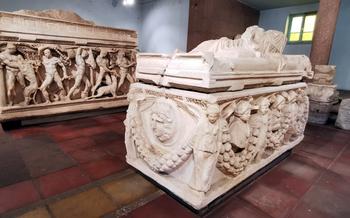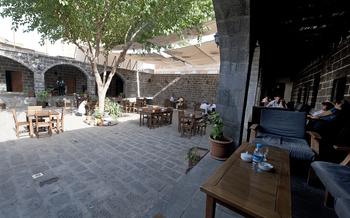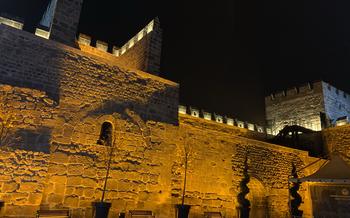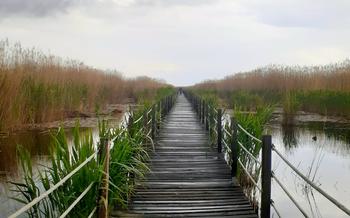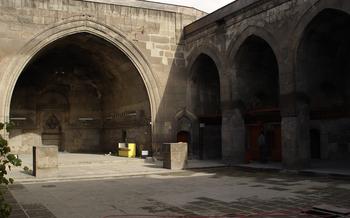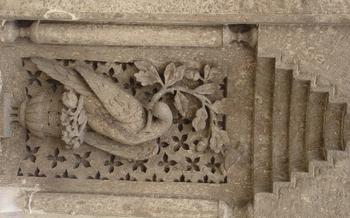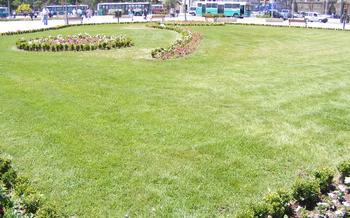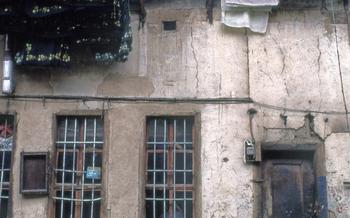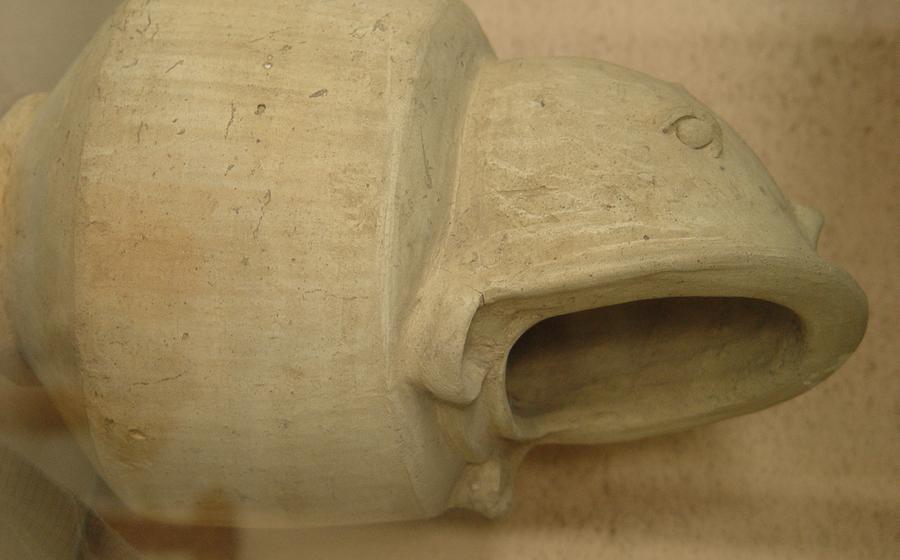
Kültepe Ancient City
- History and Significance
- The Karum of Kültepe
- The Kültepe Museum: A Treasure Trove of Ancient Artifacts
- Exploring the Archaeological Site
- The Tablets from Kültepe
- Trade and Commerce in Kültepe
- The People of Kültepe:
- The Legacy of Kültepe
- Planning Your Visit
- Guided Tours and Local Guides
- Photography and Videography
- Souvenirs and Local Crafts
- Food and Dining Options
- Accommodation and Hotels
- Insider Tip: Experiencing the Kültepe Festival
History and Significance
Kültepe, an ancient city in Kayseri, Turkey, holds a significant place in the annals of Anatolian history. Its origins can be traced back to the 4th millennium BCE, making it one of the oldest continuously inhabited settlements in the region. Kültepe flourished as a major trading center during the Bronze Age, serving as a crucial link between Mesopotamia and Anatolia. Archaeological excavations have unearthed a wealth of artifacts, including clay tablets inscribed in cuneiform script, which provide valuable insights into the city's commercial activities and cultural interactions. Kültepe's strategic location and its role in facilitating trade contributed to its prosperity and prominence in the ancient world.
The Karum of Kültepe
The Karum of Kültepe was a thriving merchant colony established in the city during the Bronze Age. This enclave played a pivotal role in the ancient trade networks of Anatolia, serving as a hub for the exchange of goods between the local population and merchants from distant lands. The Karum was organized into distinct quarters, each housing merchants from specific regions. This segregation allowed for the efficient conduct of trade and the maintenance of cultural identities.
The heart of the Karum was the assembly hall, where merchants gathered to conduct business and resolve disputes. The hall was also used for religious ceremonies and other important events. The Karum was a bustling center of activity, with merchants from all corners of the ancient world converging to buy and sell goods. The merchants traded in a variety of commodities, including textiles, metals, agricultural products, and luxury items. The use of clay tablets for record-keeping was widespread, providing valuable insights into the economic and commercial practices of the time.
The Kültepe Museum: A Treasure Trove of Ancient Artifacts
The Kültepe Museum stands as a testament to the rich history and cultural heritage of the ancient city. Established in 1948, the museum houses a remarkable collection of artifacts excavated from the Karum and surrounding areas, offering visitors a glimpse into the daily life, trade practices, and artistic expressions of Kültepe's inhabitants.
Among the highlights of the museum's collection are the clay tablets, which provide invaluable insights into the economic and social interactions of the ancient city. These tablets, inscribed in cuneiform script and the Akkadian language, document various transactions, contracts, and correspondence, shedding light on the intricate trade networks and administrative systems of the time.
The museum also boasts an impressive array of other artifacts, including pottery, jewelry, metalwork, and seals. These objects showcase the artistic prowess and craftsmanship of the people of Kültepe, demonstrating their mastery of various techniques and their appreciation for aesthetics.
A visit to the Kültepe Museum is essential for anyone seeking a deeper understanding of the city's past. The museum's well-curated exhibits, informative displays, and knowledgeable staff provide visitors with a comprehensive overview of Kültepe's significance and its enduring legacy.
Exploring the Archaeological Site
The sprawling archaeological site of Kültepe is a testament to the city's rich past. The city walls, with their imposing gates, once provided protection and security to the inhabitants. Within the walls, the ruins of temples and religious structures offer a glimpse into the spiritual beliefs of the ancient people.
The residential areas, with their well-preserved architecture, provide insights into the daily life and customs of the people of Kültepe. The narrow streets, lined with houses built of mud-brick and stone, evoke a sense of the bustling city that once stood here.
As you wander through the site, you can't help but marvel at the ingenuity and craftsmanship of the ancient builders. The intricate carvings and decorations that adorn the buildings showcase their artistic prowess and attention to detail.
Don't miss the opportunity to climb to the top of the city walls for a breathtaking panoramic view of the surrounding landscape. From up there, you can appreciate the strategic location of Kültepe, which allowed it to control trade routes and maintain its dominance in the region.
The Tablets from Kültepe
One of the most significant discoveries at Kültepe was the trove of clay tablets, which has shed invaluable light on the history and culture of the city. These tablets, numbering over 20,000, were found in various locations throughout the site, including the Karum, temples, and residential areas. They are written in cuneiform script, using the Akkadian language, which was commonly used in ancient Mesopotamia.
The content of the tablets is remarkably diverse, providing insights into various aspects of life in Kültepe. They include business transactions, legal documents, letters, and even literary texts. The tablets document trade agreements, loans, sales of land and property, and other economic activities. They also provide valuable information about the social and political organization of the city, including the names of rulers, officials, and merchants.
The tablets from Kültepe have been instrumental in reconstructing the history of the city and understanding its role in the ancient world. They have helped scholars to piece together the chronology of Kültepe's development, from its humble beginnings as a small trading outpost to its rise as a major commercial center. The tablets have also provided insights into the cultural influences that shaped Kültepe, including the interaction between the native Anatolian population and the Akkadian-speaking merchants from Mesopotamia.
The discovery of the Kültepe tablets has been hailed as one of the most important archaeological finds of the 20th century. They have revolutionized our understanding of ancient Anatolia and have provided invaluable information about the development of trade and commerce in the region. The tablets continue to be studied and analyzed by scholars, providing new insights into the history and culture of this ancient city.
Trade and Commerce in Kültepe
Kültepe's strategic location made it a thriving hub for trade and commerce in ancient Anatolia. The city served as a gateway between the East and the West, connecting the fertile plains of Mesopotamia with the mineral-rich regions of Anatolia. Merchants from far-flung lands, including Assyria, Babylonia, and the Aegean, converged in Kültepe to exchange their goods.
The types of goods traded in Kültepe were diverse and included textiles, metals, and agricultural products. The city was particularly renowned for its high-quality textiles, which were produced locally using wool and linen. These textiles were highly sought after by merchants from other regions and were exported to distant lands.
Kültepe's merchants used standardized weights and measures to ensure fair and accurate transactions. These standardized weights and measures were essential for facilitating trade between different cultures and regions, and they played a crucial role in the development of commercial practices in ancient Anatolia.
The People of Kültepe:
Kültepe was a melting pot of cultures, home to a diverse population that included merchants, scribes, artisans, and laborers from across the ancient world. The city's strategic location along trade routes attracted people from Mesopotamia, Syria, and Anatolia, creating a vibrant and cosmopolitan community.
The social structure of Kültepe was complex, with a hierarchy based on wealth and occupation. Merchants and traders held the highest status, followed by scribes and artisans. Laborers and farmers occupied the lower rungs of the social ladder.
The people of Kültepe lived in close-knit communities, with neighborhoods organized around specific occupations or ethnic groups. The city's residential areas featured a mix of modest houses and grand mansions, reflecting the diverse economic status of its inhabitants.
Daily life in Kültepe revolved around trade and commerce. Merchants traveled far and wide, bringing goods from distant lands to sell in the city's bustling markets. Scribes kept meticulous records of transactions on clay tablets, using a complex system of cuneiform writing. Artisans produced a wide range of goods, from pottery and jewelry to textiles and metalwork.
The people of Kültepe also enjoyed a rich cultural life. They celebrated religious festivals, participated in sporting events, and gathered in public spaces to socialize and exchange stories. The city was known for its music, dance, and theater performances, which drew visitors from across the region.
The Legacy of Kültepe
Kültepe's legacy extends far beyond its own time. The city played a pivotal role in the development of Anatolian civilization, serving as a cultural and economic crossroads that facilitated the exchange of ideas, goods, and technologies. Kültepe's merchant colony introduced advanced administrative and trade practices to the region, contributing to the rise of urban centers and the development of complex societies.
The city's strategic location on major trade routes made it a hub for interaction between different cultures, leading to the assimilation and adaptation of various influences. This cultural exchange gave rise to a unique blend of traditions and customs that shaped the identity of the region. Kültepe's thriving trade networks also contributed to the rise of the Hittite Empire, which emerged as a powerful force in Anatolia during the Bronze Age.
Kültepe's enduring legacy lies in its cultural and historical heritage. The city's well-preserved ruins and artifacts provide valuable insights into the lives and customs of its ancient inhabitants. The discovery of the Kültepe tablets has revolutionized our understanding of ancient Anatolian society, shedding light on its economic, social, and political structures.
Planning Your Visit
The best time to visit Kültepe is during the spring or fall, when the weather is mild and pleasant. The city is accessible by road, with several major highways connecting it to other parts of Turkey. Once in Kültepe, the archaeological site can be easily reached on foot or by public transportation.
When exploring the site, sturdy and comfortable shoes are recommended, as the terrain can be uneven in places. It's also advisable to bring a hat, sunscreen, and water, especially during the hotter months. To fully appreciate the site's significance, consider booking a guided tour. Local guides can provide valuable insights into the history and culture of Kültepe, making your visit even more enriching.
Guided Tours and Local Guides
Exploring Kültepe with a knowledgeable local guide can greatly enhance your experience. These guides, often historians or archaeologists, offer insights into the site's history, culture, and significance. They can point out hidden details, explain complex concepts, and answer your questions. Booking a guided tour is particularly beneficial if you have a limited time or want to delve deeper into the site's history.
When selecting a guide, look for reputable companies or individuals with a good track record. Read online reviews and ask for recommendations from other travelers or local tourism offices. It's also a good idea to inquire about the guide's qualifications, experience, and language proficiency.
Don't hesitate to customize your tour based on your interests. Whether you're fascinated by ancient trade networks, religious practices, or daily life in Kültepe, a good guide can tailor the tour to suit your preferences. They can adjust the pace and duration of the tour, focus on specific aspects of the site, and provide additional information and context.
Photography and Videography
Kültepe presents a treasure trove of opportunities for photography and videography. The well-preserved ruins, intricate reliefs, and sweeping vistas offer a feast for the lens. Here are some tips to capture the best shots: - Early Morning Light: Arrive at the site early to capture the soft, golden light of sunrise illuminating the ancient city. This warm glow adds a magical touch to your photographs. - Composition: Pay attention to the composition of your shots. Experiment with different angles and perspectives to create dynamic and visually appealing images. - Details: Don't overlook the smaller details. Close-ups of ancient inscriptions, pottery shards, and architectural elements can add depth and interest to your portfolio. - Respect Privacy: Be mindful of the local residents and their privacy. Ask permission before photographing people, especially women, and avoid taking pictures that may be considered disrespectful. - Regulations: Familiarize yourself with any photography or videography regulations at the site. Some areas may have restrictions on the use of tripods or professional equipment.
Souvenirs and Local Crafts
When in Kültepe, don't miss the opportunity to take home a piece of its rich history and culture. The city is renowned for its traditional handicrafts, which are a testament to the skill and creativity of its artisans. From intricate carpets and textiles to hand-painted ceramics and jewelry, there's something for every taste and budget.
Visit local markets or specialized shops to find authentic souvenirs and handicrafts. You'll find beautiful kilims, rugs, and carpets, each with unique patterns and colors. The local pottery is also exquisite, with a variety of decorative plates, bowls, and vases to choose from. Don't forget to look for hand-crafted jewelry, including intricate silver necklaces, earrings, and bracelets.
By purchasing local crafts, you not only take home a unique souvenir but also support the preservation of traditional skills and livelihoods. Engage with the artisans, learn about their techniques, and appreciate the stories behind their creations. Remember to respect local customs and haggle politely, as bargaining is a part of the shopping experience in Turkey.
Food and Dining Options
Kayseri boasts a rich culinary tradition, blending flavors from various cultures that once called the region home. While exploring the city, be sure to tantalize your taste buds with local delicacies and must-try dishes.
For a truly authentic experience, head to the local markets or sokak yemekleri (street food) stalls. Savor the delectable lahmacun, a crispy flatbread topped with minced meat, vegetables, and herbs. Indulge in the flavors of mantı, tender dumplings filled with seasoned ground beef and yogurt sauce. And don't miss Kayseri's famous pastırma, a cured and air-dried beef delicacy that adds a unique savory touch to dishes.
Several restaurants and cafes are located near the archaeological site, offering a convenient dining option for visitors. Whether you prefer a quick bite or a leisurely meal, you'll find options to suit your taste and budget.
For vegetarians and vegans, there are plenty of delicious choices available. Explore the vibrant world of meze, a selection of small dishes that can make up a complete meal. From hummus and baba ghanoush to stuffed grape leaves and grilled vegetables, there's something for everyone to enjoy.
No matter your dietary preferences, Kayseri's culinary delights are sure to leave a lasting impression. Embrace the opportunity to savor the local flavors and immerse yourself in the city's rich gastronomic heritage.
Accommodation and Hotels
When planning your trip to Kültepe, you'll find a range of accommodation options to suit different budgets and preferences. For a comfortable and convenient stay, consider booking a hotel near the archaeological site. Several hotels offer modern amenities, easy access to the ruins, and stunning views of the surrounding landscape.
To ensure a hassle-free experience, it's advisable to book your accommodation in advance, especially during the peak tourist season. This will guarantee your preferred room type and availability, particularly if you're traveling during popular times like summer or public holidays.
For those seeking a more immersive experience, homestays and local guesthouses provide an excellent opportunity to connect with the local community and learn about their way of life. These accommodations often offer a glimpse into traditional Turkish hospitality and allow you to experience the warmth and generosity of the local people.
Finally, remember to consider your budget when selecting your accommodation. Kültepe offers options ranging from budget-friendly guesthouses to luxurious hotels, catering to travelers with varying spending capacities.
Insider Tip: Experiencing the Kültepe Festival
To truly immerse yourself in the rich history and culture of Kültepe, plan your visit to coincide with the annual Kültepe Festival. This vibrant event, held in the heart of the archaeological site, celebrates the city's ancient heritage and brings the past to life.
During the festival, the streets of Kültepe are adorned with colorful decorations, and the air is filled with music, laughter, and the tantalizing aromas of traditional Turkish cuisine. Local artisans showcase their skills, displaying their handcrafted pottery, textiles, jewelry, and other traditional crafts. You'll have the opportunity to witness live demonstrations and even try your hand at some of the techniques yourself.
The festival also features cultural performances that showcase the diverse traditions of the region. From traditional folk dances and music to captivating storytelling sessions, there's something for everyone to enjoy. Engage with the friendly locals, learn about their customs, and immerse yourself in the warmth and hospitality that Kültepe is known for.
Attending the Kültepe Festival is an unforgettable experience that will leave you with a deep appreciation for the enduring legacy of this ancient city. Immerse yourself in the vibrant atmosphere, embrace the local culture, and create memories that will last a lifetime.

